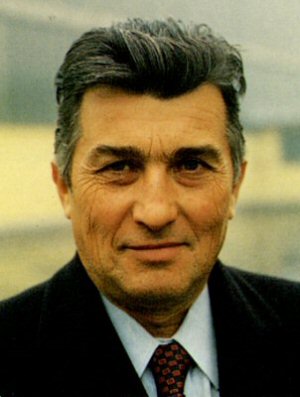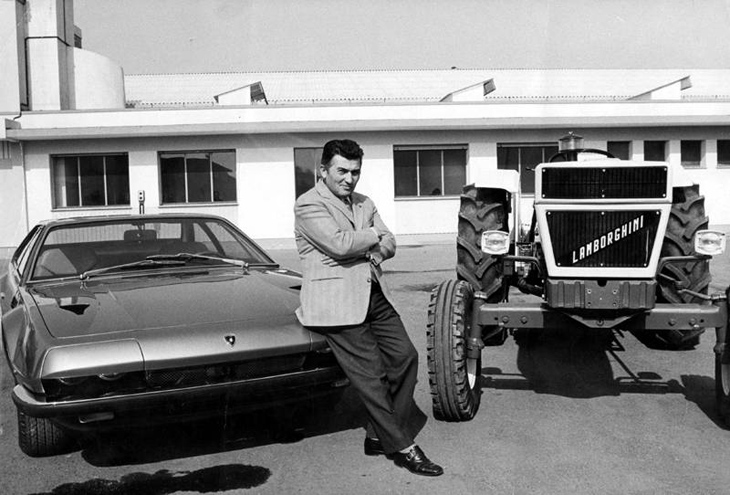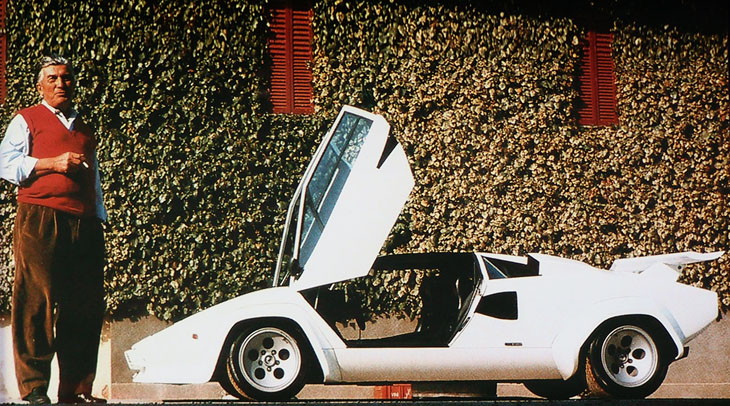 Ferruccio Elio Arturo Lamborghini (1916 – 1993) was an Italian industrialist. Born to grape farmers from the comune of Renazzo di Cento in the Emilia-Romagna region, his mechanical know-how led him to enter the business of tractor manufacturing in 1948, when he founded Lamborghini Trattori, which quickly became an important manufacturer of agricultural equipment in the midst of Italy’s post-war economic reform.
Ferruccio Elio Arturo Lamborghini (1916 – 1993) was an Italian industrialist. Born to grape farmers from the comune of Renazzo di Cento in the Emilia-Romagna region, his mechanical know-how led him to enter the business of tractor manufacturing in 1948, when he founded Lamborghini Trattori, which quickly became an important manufacturer of agricultural equipment in the midst of Italy’s post-war economic reform.
In 1959, he opened an oil heater factory, Lamborghini Bruciatori, which later entered the business of producing air conditioning equipment. In 1963, he most famously created Automobili Lamborghini, a maker of high-end sports cars in Sant’Agata Bolognese. Lamborghini founded a fourth company, Lamborghini Oleodinamica in 1969. Lamborghini sold off many of his interests by the late 1970s and retired to an estate in Umbria, where he pursued winemaking.
Ferruccio Lamborghini was born on April 28, 1916, to viticulturists Antonio and Evelina Lamborghini, in house number 22 in Renazzo di Cento, in the Province of Ferrara, in the Emilia-Romagna region of Northern Italy. According to his baptismal certificate, Ferruccio was baptised as a Roman Catholic four days later, in May As a young man, Lamborghini was drawn more to farming machinery rather than the farming lifestyle itself.
In 1940, he was drafted into the Italian Royal Air Force, where he served as a mechanic at the Italian garrison on the island of Rhodes territory of the Kingdom of Italy since 1911, after the Italian -Turkish war, becoming the supervisor of the vehicle maintenance unit. Lamborghini was taken as prisoner when the island fell to the British at the end of the war in 1945, and was not able to return home until the next year. He married, but his wife died in 1947 while giving birth to his first child, a boy named Antonio.
After the war, Lamborghini opened a garage in Pieve di Cento. In his spare time, Lamborghini modified an old Fiat Topolino he had purchased, the first of many that he would own over the years. He made use of his mechanical abilities to transform the homely city car into a roaring 750-cc open-top two-seater, and entered the car in the 1948 Mille Miglia. His participation ended after 700 miles (1,100 km) when he ran the car into the side of a restaurant in the town of Fiano, in Turin. As a result, Lamborghini lost his enthusiasm for motor racing.
Lamborghini’s increasing wealth allowed him to purchase faster, more expensive cars than the tiny Fiats he had tinkered with during his youth. He owned cars such as Alfa Romeos and Lancias during the early 1950s, and at one point, had enough cars to use a different one every day of the week, adding a Mercedes-Benz 300SL, a Jaguar E-Type coupé, and two Maserati 3500GTs. Of the latter, Lamborghini said, “Adolfo Orsi, then the owner of Maserati, was a man I had a lot of respect for: he had started life as a poor boy, like myself. But I did not like his cars much. They felt heavy and did not really go very fast.”
In 1958, Lamborghini traveled to Maranello to buy a Ferrari 250GT, a two-seat coupé with a body designed by coachbuilder Pininfarina. He went on to own several more over the years, including a Scaglietti-designed 250 SWB Berlinetta and a 250GT 2+2 four-seater. Lamborghini thought Ferrari’s cars were good, but too noisy and rough to be proper road cars, categorizing them as repurposed track cars with poorly-built interiors.
Lamborghini found that Ferrari’s cars were equipped with inferior clutches, and required continuous trips to Maranello for rebuilds; technicians would secret the car away for several hours to perform the work, much to Lamborghini’s annoyance. He had previously expressed dissatisfaction with Ferrari’s aftersales service, which he perceived to be substandard. Lamborghini brought his misgivings to Enzo Ferrari’s attention.
The exchange between Enzo Ferrari and Ferruccio Lamborghini is often cited as a primary factor that motivated Lamborghini to become an auto manufacturer. In a 1991 Thoroughbred & Classic Cars interview, Lamborghini said that after the clutch problems with his Ferrari continued to go unresolved, “I decided to talk to Enzo Ferrari. I had to wait for him a very long time. ‘Ferrari, your cars are rubbish!’ I complained. Enzo Ferrari was furious. ‘Lamborghini, you may be able to drive a tractor but you will never be able to handle a Ferrari properly.’ This was the point when I finally decided to make a perfect car.” Lamborghini states that “Ferrari never spoke to me again. He was a great man, I admit, but it was so very easy to upset him.”
After successfully modifying one of his personally-owned Ferrari 250GTs to outperform stock models, Lamborghini gained the impetus to pursue an automobile manufacturing venture of his own, aiming to create the perfect touring car that he felt no one could build for him. Lamborghini believed that a grand tourer should have attributes that were lacking in Ferrari’s offerings, namely high performance without compromising tractability, ride quality, and interior appointments. A clever businessman, Lamborghini also knew that he could make triple the profit if the components used in his tractors were installed in a high-performance exotic car instead.
During the 1970s, Ferruccio Lamborghini’s companies began to run into financial difficulties. In 1971, Lamborghini Trattori, which exported around half of its production of tractors, ran into trouble when its South African importer cancelled all its orders. In Bolivia, the new military government, which had recently staged a successful coup d’état, cancelled a large order of tractors that was being prepared for shipment in Genoa. Trattori’s unionised employees could not be laid off, putting immense strain on the company. In 1972, Lamborghini sold his entire holding in the company to rival tractor builder SAME.
Soon, the entire Lamborghini group found itself in financial trouble. Development at the automaker slowed as costs were cut. Ferruccio Lamborghini began courting buyers for Automobili and Trattori, entering negotiations with Georges-Henri Rossetti, a wealthy Swiss businessman and friend. Ferruccio sold Rossetti 51% of the company for US$600,000, thereby relinquishing control of the automaker he had founded. He continued to work at the Sant’Agata factory; Rossetti rarely involved himself in Automobili’s affairs.
The situation did not improve: the 1973 oil crisis plagued sales of high performance cars of manufacturers from around the world. Consumers flocked to smaller, more practical modes of transportation with better fuel economy. By 1974, Ferruccio had become disenchanted with his car business. He severed all connections with the cars that bore his name, selling his remaining 49% stake in the automaker. The shares were acquired by René Leimer, a friend of Georges-Henri Rossetti.
After departing the automobile manufacturing business, Lamborghini continued his business activities in other areas, including his heating and air conditioning company, Lamborghini Calor. In 1969, he founded Lamborghini Oleodinamica S.p.A., a manufacturer of hydraulic valves and equipment.
In 1974 Lamborghini exited the industrial world and retired to an 740-acre (3.0 km2) estate named “La Fiorita” on the shores of Lake Trasimeno, in Castiglione del Lago, a town in the Umbria region of central Italy. Returning to his farming roots, Lamborghini delighted in hunting and producing his own wines. Lamborghini even designed his own golf course, all while continuing to manage several business interests.
Lamborghini remarried, and at age 58, fathered a child, Patrizia, with his third wife. At 76 years of age, on February 20, 1993, Lamborghini died at Silvestrini Hospital in Perugia after suffering a heart attack fifteen days earlier. Lamborghini is buried at the Monumental Cemetery of the Certosa di Bologna monastery.




You must be logged in to post a comment.